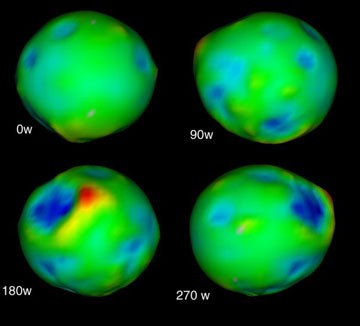Saturn's mystery moon shows exposed water ice, says Cornell researcher
By David Brand
PASADENA, Calif. -- Saturn's mysterious moon, Phoebe, which has puzzled astronomers for more than a century because of its dark surface and retrograde orbit, has great geological variety, and probably has large areas of exposed water ice, Cornell senior astronomy researcher Peter Thomas told a press conference at the Jet Propulsion Laboratory (JPL) here today (June 23).
The Cassini spacecraft flew within 1,250 miles of the 133-mile-diameter Phoebe on June 11, and mission scientists are now concluding that Phoebe is likely a primordial mixture of ice, rock and carbon-containing compounds similar in to material seen on Pluto and Neptune's moon Triton.
Thomas described images of "materials streaming down" in large landslides on the surface of Phoebe, revealing a number of surface materials. "There is a geological variety at the surface, as well as a variety of materials that make up Phoebe," he said at the press briefing. However, he noted, the surface does not seem to be simply made up of layers. "At first blush, it looks more complicated than that," he said.
One thing Phoebe is not is a captured asteroid, a long-held theory. "Phoebe is definitely not an asteroid," said JPL scientist Bonnie Buratti, a 1983 Cornell astronomy graduate. Instead, said JPL mission scientist Amanda Hendrix, "Phoebe probably is a captured object. Water ice is a telltale sign that Phoebe originated somewhere in the solar system beyond the asteroid belt [between Mars and Jupiter] and was formed somewhere in the outer solar system."
Launched in 1997, Cassini will go into orbit around Saturn, the second largest planet in the solar system, on June 30 at approximately 10:30 p.m. EDT. It will then spend four years making an extensive tour of the giant planet's rings and 31 known moons. The Cassini mission is a cooperative project of NASA, the European Space Agency and the Italian Space Agency.
Thomas, a specialist in small satellites and small-satellite encounters, is a member of the Cassini imaging team. After Cassini's flyby of the moon he noted important differences between the surface of Phoebe and that of rocky asteroids which have been seen at comparable resolution. "Asteroids seen up close, like Ida, Mathilde, and Eros, and the small Martian satellites do not have the bright speckling associated with the small craters that are seen on Phoebe," he said.
Other Cornell researchers involved with the mission are Joseph Burns, the Irving Porter Church Professor of Engineering, Theoretical and Applied Mechanics, professor of astronomy and Cornell's vice provost for physical sciences and engineering; Joseph Veverka, professor and chair of the Department of Astronomy; and astronomy professors Steve Squyres, Peter Gierasch and Philip Nicholson.
Buratti told today's press conference that both carbon dioxide and a simple hydrocarbon have been detectred on Phoebe. The water ice, she said, seems to be associated with a very bright material and there are bright craters and areas that seem to be rich with ice. "There seem to be minerals found with the water, and also an unidentified mystery material tied up with dark material," she said.
Phoebe's mass was determined from precise tracking of the spacecraft and optical navigation, combined with an accurate volume estimate from images. The measurements yield a density of about 1.6 grams per cubic centimeter (100 pounds per cubic foot), much lighter than most rocks, but heavier than pure ice at approximately 0.93 grams per cubic centimeter (58 pounds per cubic foot).
Torrence Johnson, a Cassini imaging team member from JPL, said that this density "tells us automatically this is not a pure iceball with a thin dark layer. You would never get a density of 1.6 from something like that. Inside, Phoebe has to be fairly complex and has to include some processes to produce these clean layers underneath the surface, which is a deep carbonaceous and rock-rich surface."
Get Cornell news delivered right to your inbox.
Subscribe